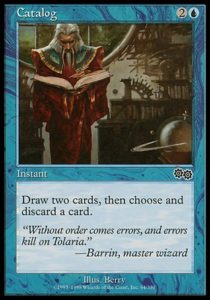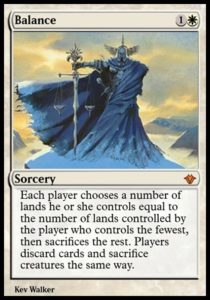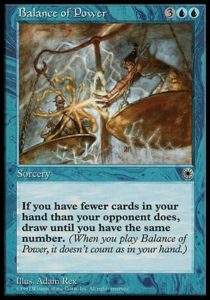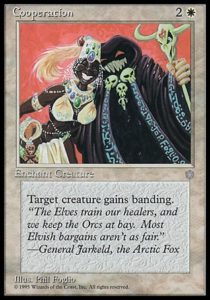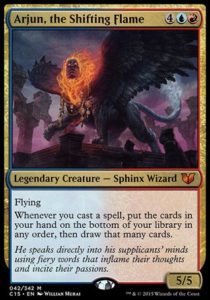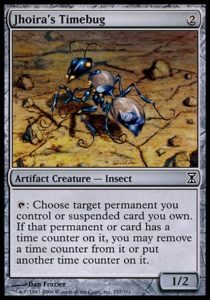Every year, we’re treated to at least five brand new Limited formats. This year, we get six: Oath of the Gatewatch, Shadows Over Innistrad, Eternal Masters, Eldritch Moon, Conspiracy, and the unnamed large Fall set. Every format feels different, and that’s not just because the cards and mechanics are different. Every set has different qualities. For example, Khans of Tarkir was a multicolored set with high complexity and relatively slow speed (owing heavily to morph), whereas Theros stressed monocolored decks (because of devotion) and big, individual threats (due to heroic and monstrosity).
Today, I’d like to consider just what qualities differentiate sets. Later on, we’ll delve into something more subjective but worth considering: what makes for better or worse Limited formats?
There are many qualities which differentiate Limited formats. These are the ones which make the most sense to me. I imagine each of these as a spectrum (and spoilers, I believe that danger lies at the extremes of most of them). They are:
- Balance
- Power
- Synergy
- Replayability
- Fixing
- Sweetness
- Interaction
Balance is a measure of how wide the power disparity is between different color combinations or archetypes.
First and foremost, I don’t believe that the existence of a format having a ‘best deck’ is evidence of it being unbalanced; in fact, I believe that there will always be a de facto ‘best deck.’ No format is perfectly balanced. One color will have the greatest number of top tier commons or one archetype’s power will dwarf the others’. However, this creates a balancing act, where players respond to the metagame by overdrafting the ‘best’ deck or color and undersrafting the ‘worse’ ones. When considering a format’s balance, I ask three questions, and all of them start the same way. How big is the power level difference between:
- The best deck/color/archetype and the average?
- The best and the worst?
- The average and the worst?
Heavily unbalanced formats tend to get a bad reputation, and for good reason. Battle for Zendikar is unbalanced because its worst color, green, is so bad that it’s almost unplayable. If a color is so weak that it being heavily underdrafted doesn’t counteract its low power, then the format is the worse for it (by eliminating a color, four entire color pairs are lost, limiting a draft from ten possible color pairs to six). A format I consider a good exemplar of balance is Gatecrash: while white and red-based decks were considered the best and blue-based decks the worst, Dimir and Simic were strong enough that (when underdrafted), they could beat the more powerful Boros, Orzhov, and Gruul decks.
Power is a measure of a format’s power level. This includes several questions, such as:
- How many higher rarity cards are incredibly strong?
- How many lower rarity cards incredibly strong?
- How many commons are playable in one or multiple decks?
One might think that more powerful formats are better because high power level leads to exciting games, or that weaker formats are better because player decisions are more important than resolving bombs. I don’t think that there’s a right answer to power level and that each extreme is problematic.
- Formats with extremely powerful commons, like [casthaven]Mist Raven[/casthaven] in AVR, [casthaven]Triplicate Spirits[/casthaven] in M15, or [casthaven]Doom Blade[/casthaven] in M11 tend to feel very redundant (as games are frequently being decided by the same cards which are opened every draft).
- Conversely, if a format lacks clear best commons and the power level is too low, drafting becomes difficult. I consider Champions of Kamigawa to suffer from this problem (it has a lot of weak, but playable commons). In such formats, it’s difficult to form heuristics (rules of thumb), making rather mundane drafting decisions feel consequential, when many aren’t. Decks will feel and play similarly, since cards are weaker and more interchangable (mirroring the problem with extremely powerful commons).
- Formats with many extremely powerful bombs, like Scars of Mirrodin, run the risk of every game being decided by who resolved their bomb first. This diminishes player agency, since many games are decided by who drew their best card and the mana to cast it first.
Synergy is a measure of whether players are encouraged to draft archetypes (where a card’s value is determined by what other cards it interacts with) or ‘good stuff’ (where cards behave and are valued similarly across color combinations). Most formats have some specific archetypes alongside more flexible archetypes (for example, infect was a very parasitic mechanic in Scars of Mirrodin draft and contorted black/green decks, whereas other colors and strategies had more flexibility).
I freely admit that I love synergy, but it has its limits. If a format has too much synergy, then what matters most is having the correct combination of cards. In such drafts, players will quickly identify their archetype and then go on autopilot, picking the best card for that deck out of every pack (which is filled with irrelevant cards). Drafts will quickly become stale, as players will learn and draft all existing archetypes, seeing little variety between successive drafts. This is known as drafting on rails, and was a problem in Lorwyn and is a recurring theme in Modern Masters products.
If a format lacks synergy, then cards’ power levels will be relatively context-independent. Cards will tend to perform similarly across archetypes and color combinations and the format will be defined by how many copies of the best commons/bombs a player has. This can also make a format quickly become stale.
Replayability is a measure of how long it takes for a format to become stale. The more replayable the format, the longer it will take to master and the longer it will hold player interest.
Replayability is a softer measure which combines Power, Synergy, and Balance. We’ve already mentioned what can accelerate a format becoming stale (if the power level is too flat or high, if the format is too unbalanced, if there is too much or too little synergy). We can extrapolate that longer-lived formats have decks, archetypes, matches, and drafts which feel different. If there are twelve distinct archetypes, it will take more time to learn the format than if there are six. If those archetypes aren’t heavily differentiated (say, due to there being low synergy or specific powerful commons which dominate the format), then some of those archetypes will essentially be or feel the same, diminishing the format’s lifecycle. If the format has the fixing to allow 3+ color decks or the synergy to allow monocolor decks, then further replayability becomes possible.
As I’ve defined it, replayability is a good thing which every format strives to maximize. It’s also very subjective, as it engages players’ preferences. While I loved Khans of Tarkir block and didn’t enjoy Dragons of Tarkir, others love playing with Dragons while they couldn’t wait for Khans to go away. While I believe that replayability has some objective measures (such as power, synergy, and balance), it’s the least objective measure of a Limited format introduced so far.
That’s it for this week. Join us next week when we consider Fixing, Sweetness, and Interaction, as well as break down recent Limited formats. Oh, and all of Shadows Over Innistrad will be spoiled, so we’ll have that to talk about, too. Life’s just nice like that sometimes.
And as always, thanks for reading.
—Zachary Barash
Zachary Barash has been playing Magic on and off since 1994. He loves Limited and drafts every available format (including several that aren’t entirely meant to be drafted). He’s a proud Cube owner, improviser, and game designer (currently going for an MFA in Game Design at NYU). He has an obsession with Indian food that borders on being unhealthy.

